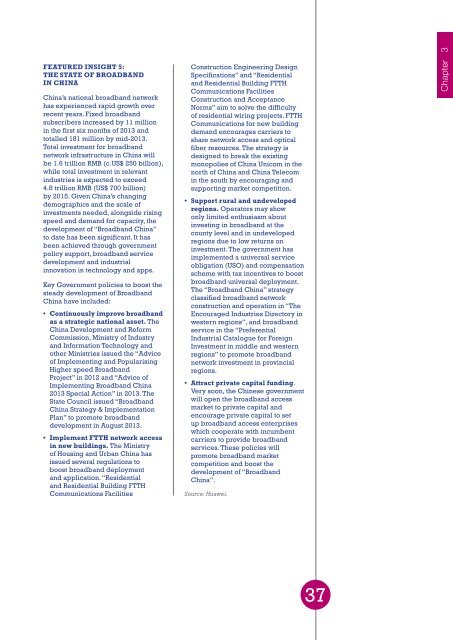DI8xz
DI8xz
DI8xz
Create successful ePaper yourself
Turn your PDF publications into a flip-book with our unique Google optimized e-Paper software.
Featured Insight 5:The State of Broadbandin ChinaChina’s national broadband networkhas experienced rapid growth overrecent years. Fixed broadbandsubscribers increased by 11 millionin the first six months of 2013 andtotalled 181 million by mid-2013.Total investment for broadbandnetwork infrastructure in China willbe 1.6 trillion RMB (c.US$ 250 billion),while total investment in relevantindustries is expected to exceed4.8 trillion RMB (US$ 700 billion)by 2015. Given China’s changingdemographics and the scale ofinvestments needed, alongside risingspeed and demand for capacity, thedevelopment of “Broadband China”to date has been significant. It hasbeen achieved through governmentpolicy support, broadband servicedevelopment and industrialinnovation in technology and apps.Key Government policies to boost thesteady development of BroadbandChina have included:• Continuously improve broadbandas a strategic national asset. TheChina Development and ReformCommission, Ministry of Industryand Information Technology andother Ministries issued the “Adviceof Implementing and PopularisingHigher speed BroadbandProject” in 2012 and “Advice ofImplementing Broadband China2013 Special Action” in 2013. TheState Council issued “BroadbandChina Strategy & ImplementationPlan” to promote broadbanddevelopment in August 2013.• Implement FTTH network accessin new buildings. The Ministryof Housing and Urban China hasissued several regulations toboost broadband deploymentand application. “Residentialand Residential Building FTTHCommunications FacilitiesConstruction Engineering DesignSpecifications” and “Residentialand Residential Building FTTHCommunications FacilitiesConstruction and AcceptanceNorms” aim to solve the difficultyof residential wiring projects. FTTHCommunications for new buildingdemand encourages carriers toshare network access and opticalfiber resources. The strategy isdesigned to break the existingmonopolies of China Unicom in thenorth of China and China Telecomin the south by encouraging andsupporting market competition.• Support rural and undevelopedregions. Operators may showonly limited enthusiasm aboutinvesting in broadband at thecounty level and in undevelopedregions due to low returns oninvestment. The government hasimplemented a universal serviceobligation (USO) and compensationscheme with tax incentives to boostbroadband universal deployment.The “Broadband China” strategyclassified broadband networkconstruction and operation in “TheEncouraged Industries Directory inwestern regions”, and broadbandservice in the “PreferentialIndustrial Catalogue for ForeignInvestment in middle and westernregions” to promote broadbandnetwork investment in provincialregions.• Attract private capital funding.Very soon, the Chinese governmentwill open the broadband accessmarket to private capital andencourage private capital to setup broadband access enterpriseswhich cooperate with incumbentcarriers to provide broadbandservices. These policies willpromote broadband marketcompetition and boost thedevelopment of “BroadbandChina”.Source: Huawei.Chapter 337


